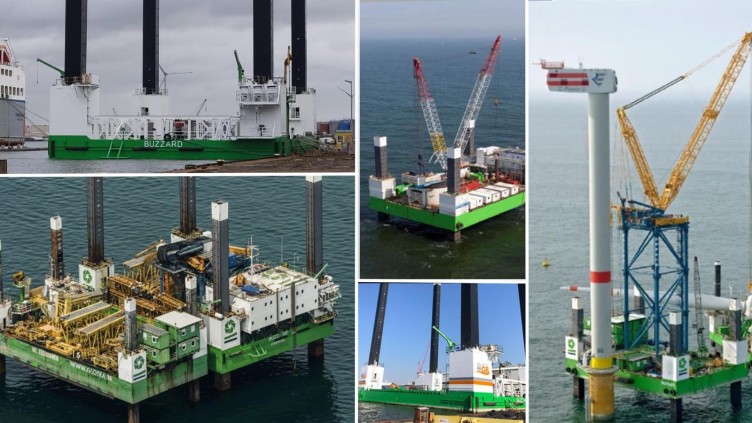Farewell to the Marine Construction icon: jackup ‘Buzzard’ bucks the trend
News
In July ’24, the jackup construction barge ‘Buzzard’ performed her final project in the marine construction industry before being transferred to the Oil and Gas market in W Africa, where she will be standing alongside oil platforms enabling the extension of life of near-depleted wells.
History and Specifications
This marks the passing of a generation of construction jackup barges, which have already travelled that route before her and a symbolic sale for DSB Offshore. It’s a symbolic milestone, as DSB began trading in 1981, just months before ‘Buzzard’ entered service. Over the years, we have brokered her for numerous projects across Europe-wide.
One of three sister barges with bird names (the others being ‘Stork’ and ‘Heron’), ‘Buzzard’ was originally built in 1982 for the Netherlands construction company, Ballast Nedam and went on to be owned by Jackupbarge B.V., Geosea (DEME Group) and Jackup GB Ltd. She was one of the larger piling jackups in the marine construction world, with dimensions of 45 x 30m, 1,300t payload and 4 x 55m legs.
Notable Projects
Over the years, ‘Buzzard’ was involved in some significant and varied projects.
LNG Terminals
In the 1990s and early 2000s, she found her sweet spot in piling jetties for LNG terminals, an example of which was an LNG Terminal in Milford Haven, U.K.
Offshore Wind Farms
‘Buzzard’ was a pioneer in early windfarm projects, when there were few bespoke WIVs – namely:
- C-Power Thornton Offshore Windfarm (DEME, offshore Belgium, 2007-2013). Equipped with CC2500 crane mounted on a 40m pedestal frame of 18 x 18m, she assembled the four sections of the wind turbines and knocked in piles for the gravity foundations. This windfarm was in itself special as it broke records and set precedents being the largest of its kind at 325MW; the furthest offshore at 25/30km from land; and having the largest turbines of its day at 5-6MW each.
- Alfa Ventus, Germany’s first offshore windfarm in Borkum. Once again with a CC 2500 crane, she hammered 24 pre-piles and installed wind blades by jacking up almost to the top of her legs – an extreme position for such a unit.
Wreck Removal
In addition, ‘Buzzard’ was used in innovative ways for wreck removal. In 2003, SMIT Salvage won the contract to remove the wreck of the 16,000DWT, 190m LOA, Vehicle Carrier ‘Tricolor’. For this they employed ‘Buzzard’ and another jackup both with large winches to cut up the hull into 9 sections – the largest ever vessel to be cut in pieces in this way.
Final Project and Transition
Ironically, ‘Buzzard’s sale outof the construction industry comes at a time when the industry is experiencing great demand for such units.
Notably, LNG terminal construction (particularly import terminals) is booming partly due to the disruption of existing gas trade routes produced by the Russia-Ukraine conflict. ‘Buzzard’ was designed for such work and feels particularly at home in it.
It is thus fitting that the very last project carried out by ‘Buzzard’ and brokered by DSB was for the original owner, Ballast Nedam, on an LNG terminal in Wilhelmshaven, finishing days before she transitioned to her new owners.
A big thank you to Martin Spurr of Jackup Barge GB for engaging us to sell the jackup, and to our co-broker, Jean Cruse at BRS, for working with us on this.
We wish ‘Buzzard’ a safe flight to W Africa and a happy migration to a new role in a new industry!
The Future of Construction Jackups
As brokers, today we see that alongside their conventional function as platforms for piling works, larger jackups are being put to novel, alternative uses. For example, self-elevating platforms are used for pop-up port facilities (vintage units ‘Karlissa A’ and ‘Karlissa B’ are currently used like this in Mozambique), for UXO clearance and near shore cable lay on windfarms. Conventional jackup platforms are even being used purely as piling templates for large-diameter piling by modern large Windfarm Installation Vessels (WIVs).